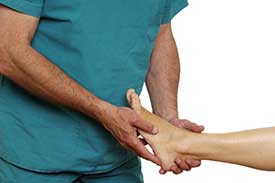Posterior Tibial Tendonitis Treatment in Roanoke, TX

Ever been called flat footed? Unless you're a police officer from decades past, you might have an inflamed or torn tendon. Posterior tibial tendonitis is a condition that affects the tendon connecting your calf muscle to the inside arch supporting bones of the foot. Tendonitis to the posterior tibial tendon can, over time, result in a collapsing of your arches—with pain not too far behind.
A tendon is tissue that connects muscle to bone, and is a key part of biomechanics and how we move about. When one of these becomes injured, damaged or inflamed, a task as simple as walking can become intolerably painful.
Symptoms of Posterior Tibial Tendonitis
Common symptoms of this condition can include:
- Pain along the inside of the foot, up through the ankle and lower leg
- Swelling may be present in the region as well
- Pain performing high-impact activities (sports, running), or even standing and walking in severe cases
- Arthritis pain localized in the back of the foot due to shifting bones
Those of us that are most at risk include women, people over the age of 40, those with obesity , high blood pressure , and diabetes . Also those who play or have played high-impact sports like soccer, basketball, running and tennis.
How is Posterior Tibial Tendonitis Diagnosed?
Your doctor may perform what's called the “too many toes” sign, a test where the foot is inspected from behind the leg with the patient standing. Typically the fifth and part of the fourth toes can be seen, but in people who suffer from posterior tibial tendonitis, nearly all (sometimes all) the toes can be seen. The foot in essence, points outward.
Another test is to have the patient balance on one foot and raise up to balance on their toes. Those who suffer from an inflamed Tibial Tendon have great difficulty completing this task.
How is Posterior Tendonitis Treated?
After performing several diagnostic tests, including an X-ray, MRI, CT scan and an ultrasound , your doctor may recommend two courses of treatment, non-invasive home care or surgery.
With non-invasive treatments:
- Rest is recommended to avoid injuring the tendon further.
- Ice to reduce inflammation
- Anti-inflammatory drugs to keep the swelling down
- Orthotics and braces to support the week tendon
- Physical therapy
- And sometimes a Cortisone shot (this option is reserved as a last resort before surgery because injected steroids can cause a rupture/tear in the tendon).
If these options fail for more than six months, surgery might be the next option. However, due to the location of the tendon, surgery is risky, often resulting in limited mobility and dexterity post-procedure. The types of procedures include:
- Gastrocnemius Recession (Tendon Lengthening): Lengthening of the calf muscle.
- Tenosynovectomy (tendon cleaning): Removal of the inflamed tissue surrounding the tendon
- Tendon Transfer: Reappointing tendon (from the big or little toe) to replace the damaged posterior Tibial tendon.
- Osteotomy: Cutting the heel bone to produce a natural arch or performing a bone graft to elongate the foot.
- Fusion (Arthrodesis): Similar to spinal fusion, bones are joined to eliminate arthritis and produce a more natural stance.
If you've suddenly found yourself flat-footed, experiencing pain on the inner side of your ankle and have difficulty walking, running or performing high-impact activities and sports, you may have posterior tibial tendonitis.
Request more information about Posterior Tibial Tendonitis today. Call (817) 203-2760 or contact The New You Medical & Infusion Clinic online.
The New You Medical & Infusion Clinic
Address
100 Grapevine HwyHurst, TX 76054
(817) 203-2760
https://www.newyoumedclinic.com/
Hours
Mon:
10:00 am - 6:00 pm
Tue:
10:00 am - 6:00 pm
Wed:
10:00 am - 6:00 pm
Thu:
10:00 am - 6:00 pm
Fri:
Closed
Sat:
Closed
Sun:
Closed

